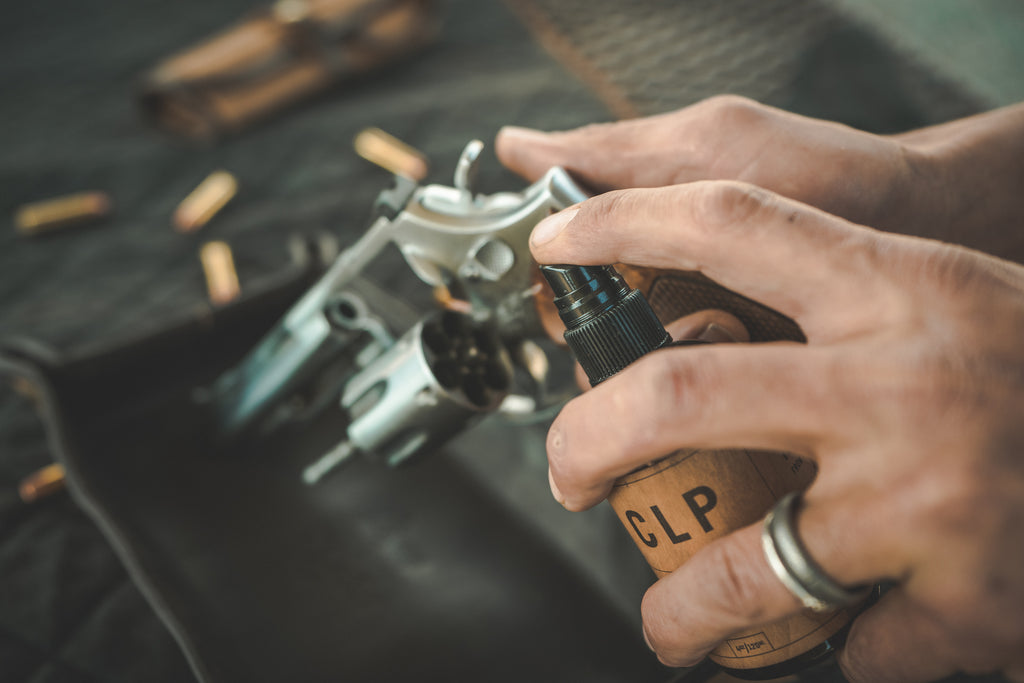CLP: A Solvent for Gun Cleaning

Gun cleaning solvent is an essential element of proper gun maintenance and care. It is formulated to break down fouling from use while not damaging the firearm's finish. Solvents come in many forms that have various levels of effectiveness. CLP or “Clean, Lube, Protect” is an excellent solvent, attacking copper, lead, and carbon fouling while also lubricating internal and external parts.
What Does a Gun Cleaning Solvent Do?
A gun cleaning solvent, by definition, is a substance capable of breaking down or dissolving another substance. In the case of firearms solvents, the substances that need to be dissolved are carbon, copper, and lead. The other dirt and grime that builds up inside a firearm are typically pretty easy to remove using the same solvents. A lot of the clean-up that needs to be addressed inside a firearm is caused by an excess of dried up oil. This is why it is essential to use the correct types of solvents and lubricants.
A good solvent for gun cleaning will attack the fouling on a microscopic level, breaking down build-ups in the most minor and hardest-to-reach areas. A solvent doesn’t work entirely on its own. When used in conjunction with copper and nylon brushes, it can remove any amount of fouling without issue.

Characteristics of Cleaning Solvents
The viscosity matters. The viscosity is the solvent's thickness or its resistance to deformation. An easy way to think of this is if you were to put a droplet of it on a flat piece of metal, does it hold the drop form? Or immediately disperse into a thin puddle? Ideally, it should disperse into a thin puddle. This translates to getting into every corner and hard-to-reach area inside a firearm action for cleaning.
As mentioned briefly before, to be an effective gun cleaning solvent, it can not damage the metal finish. There are plenty of exceptional solvents outside of the gun world that will do the job but may also remove your bluing or other metal finishes. If you are using a solvent also advertised as a rust remover, you need to be careful. It might work with some of the more durable Cerakote finishes, but bluing is a form of rust and could be removed in the process. Along the same lines, the solvent should give you some corrosion protection.
Knowing what we now do about solvents, it is safe to assume that some of these liquids and chemicals being used can be harmful to us if we are exposed to them frequently. This is true with some solvents and should be considered when looking for the right product. One of the reasons I like CLP so much is that it is non-toxic.
CLP is also a Lubricant
In some cases, solvents are also lubricants! Sage & Braker’s CLP does a great job at both. It creates the lubrication necessary to reduce friction and wear on the firearm's internals, making everything feel smooth during operation. Its thin consistency means it won’t run like some heavier oils do.
The advantage of using a cleaner that is both a solvent and a lubricant is self-explanatory. When using more caustic solvents, you need to make sure you remove all of the excess so that it doesn’t continue to damage the steel over the long term.

Typically, strict bore cleaners are not made to lubricate and protect the bore after cleaning. They are made to be used in conjunction with corrosion resistant oils. Therefore, it adds an extra step in the cleaning process. If you are using a pull through bore snake, that means you will have to mix solvents and oils during cleaning. Having one that does it all is best in this scenario.
How to Use CLP
Before use, please ensure the firearm that you intend to clean is cleared and unloaded.
- First, disassemble the firearm to the appropriate level. Most of the time, it will be a simple field strip, but sometimes it will need to be broken down into each and every part. A thorough cleaning like this should be done by a mechanically competent individual or a qualified gunsmith.
- Next, apply CLP to the areas that you want to clean. Spray small parts and run a moist patch through the gun's bore. There is no right amount to apply here as most of it will be removed before reassembly. However, make sure you have enough coverage to allow it to penetrate the dirt and grime.
- Wait 15-20 minutes. This allows the solvent ample time to penetrate the fouling.
- Scrub the affected area. Using a copper or nylon cleaning brush, remove the copper, lead, or carbon fouling. You don’t need to apply a lot of pressure here; you will see the area start to clear up. Repeat steps 2-4 until fouling is fully removed. For the bore, use a copper bore brush to do the same thing as the brushes.
- Wipe off the excess oil. CLP is also a protectant and lubricator however, wiping the excess off ensures you remove any fouling or residue that may be left on the gun.
- Reapply CLP Lightly. Adding a light coat of CLP will protect the metal parts from corrosion and oxidation. Take care not to over-oil at this stage. Here is the full article on Properly Lubricating Your Firearm if you want to know more about this step.
- Reassemble the Gun.
CLP is a Good One & Done Solution
If you are a hunter or hobbyist shooter, CLP will do everything you need it to. It is your solvent/bore cleaner, lubricating oil, and rust preventative all in one. The perfect addition to the minimalists gun cleaning kit, reducing the amount of cleaning supplies needed to do the periodic cleaning and maintenance of your guns.

Although I believe that a one and done CLP type cleaner is best for most people, there are scenarios when a single purpose cleaner is better. For example, when a bore has heavy copper or lead fouling, it might be better to use a product designed for that specific purpose. CLP can do the job, but it may take you a little longer. These situations tend to be the exception not the norm and usually are indicators of a bigger problem that needs to be addressed.
Also, some firearm components are better suited for a grease rather than a light oil. These firearm greases are best suited for high friction or high wear areas like the pivot pin on a break open rifle or shotgun. This grease is thick and will stay where you put it even when exposed to a hot summer day at the range.
This article was written in pretty simple terms, helping the reader understand what to look for in a gun cleaning solvent. If you are curious about the technical side of what makes Sage & Braker’s CLP what it is, check out this article. It covers all of the science behind it and compares its performance to the other gun oils on the market. While it is a bit pricier than some of its competitors, it’s for a good reason.
Written by Kurtis Martonik
